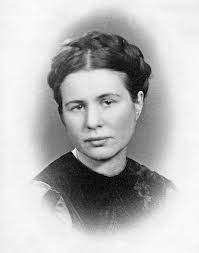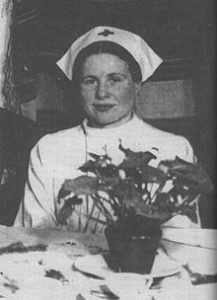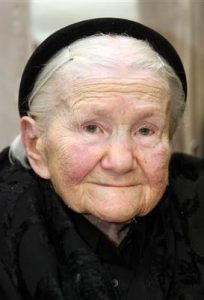 Some would consider the actions of Irena Sendler a crime, while others would consider them heroic. I suppose it was a crime, at the time it happened…a crime of opportunity, because her actions were illegal, but how could she had done anything different? Irena Sendler was born in Otwock, Poland, on February 15, 1910, to Stanislaw Henryk Krzyzanowski, a physician, and his wife, Janina Karolina Grzybowska Krzyzanowski. Irena grew up there in Otwock, a town about 15 miles southeast of Warsaw, where there was a Jewish community. Her father was a kind man who treated the very poor, including Jews, free of charge. Stanislaw died in February 1917 after he contracted typhus from his patients. After his death, the Jewish community offered financial help for the widow and her daughter, though Janina Krzyzanowski declined their assistance. I’m sure she knew they really didn’t have the money to help, but offered because of her husband.
Some would consider the actions of Irena Sendler a crime, while others would consider them heroic. I suppose it was a crime, at the time it happened…a crime of opportunity, because her actions were illegal, but how could she had done anything different? Irena Sendler was born in Otwock, Poland, on February 15, 1910, to Stanislaw Henryk Krzyzanowski, a physician, and his wife, Janina Karolina Grzybowska Krzyzanowski. Irena grew up there in Otwock, a town about 15 miles southeast of Warsaw, where there was a Jewish community. Her father was a kind man who treated the very poor, including Jews, free of charge. Stanislaw died in February 1917 after he contracted typhus from his patients. After his death, the Jewish community offered financial help for the widow and her daughter, though Janina Krzyzanowski declined their assistance. I’m sure she knew they really didn’t have the money to help, but offered because of her husband.
In 1931, Irena married Mieczyslaw Sendler, and the couple moved to Warsaw before the outbreak of World War II. The couple divorced in 1947. Irena then married Stefan Zgrzembski. They had three children, Janina, Andrzej (who died in infancy), and Adam (who died of heart failure in 1999). Then, they divorced in 1957. She remarried Mieczyslaw Sendler in 1961, but they divorced again in 1971. In college, Irena  had studied to became a social worker, and she remembered the lessons of her father…to show kindness to others. It was a life lesson that would prove useful in Irena’s future.
had studied to became a social worker, and she remembered the lessons of her father…to show kindness to others. It was a life lesson that would prove useful in Irena’s future.
When the Nazis invaded Poland in 1939, Irena had access to the Warsaw Ghetto through her job. The ghetto was where hundreds of thousands of Jews were imprisoned. The situation there appalled her. Irena became a member of the Council to Aid Jews, and worked as a social worker, overseeing the city’s canteens, which provided assistance to people in need. After the Nazi invasion, Irena and her colleagues also used the canteens to provide medicine, clothing and other necessities to the city’s persecuted Jewish population. Her actions enabled her to help rescue 2,500 Jewish children from the ghetto. The group had several ways of smuggling the children out of the ghetto. Some were carried out in caskets or potato sacks, while others left in ambulances or snuck out through underground tunnels. Still others entered the Jewish side of a Catholic church that straddled the ghetto boundary and left on the other side with new identities. Irena then helped place the children at convents or with non-Jewish families. The operation was run with clockwork-like precision. As the situation grew worse for the ghetto’s inhabitants, Irena went beyond rescuing orphans and began asking parents to let her try to get their children to safety. Although she couldn’t guarantee the children’s survival, she could tell parents that their children would at least have a chance. The parents knew that it would be their  children’s only chance. Irena kept detailed records and lists of the children she helped buried in a jar. She planned to reunite the rescued children and their parents after the war. Unfortunately, most of the parents did not survive.
children’s only chance. Irena kept detailed records and lists of the children she helped buried in a jar. She planned to reunite the rescued children and their parents after the war. Unfortunately, most of the parents did not survive.
On October 20, 1943, the Nazis arrested Irena and sent her to Pawiak Prison. She was tortured in an attempt to get her to reveal the names of her associates. She refused and was sentenced to death. However, Council to Aid Jews members bribed the prison guards, and Irena was released in February 1944. Irena continued her work until the war ended, by which time she and her colleagues had rescued approximately 2,500 children. It has been estimated that Irena personally saved about 400 children. In 1965, Irena was honored for her courageous actions during the Holocaust. She was given Israel’s Yad Vashem to honor her as “Righteous Among the Nations.” Irena died in Warsaw, Poland on May 12, 2008, at the age of 98.


3 Responses to A Crime Of Opportunity